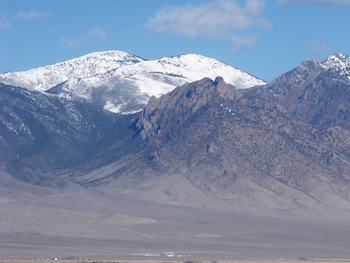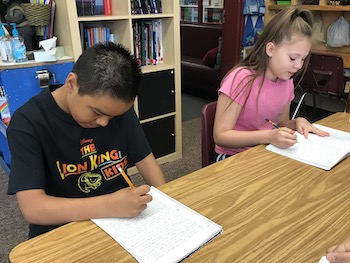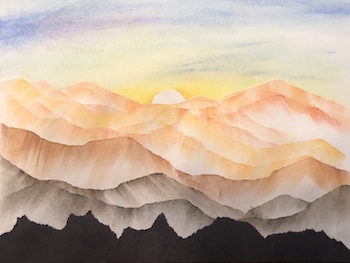SUBJECTS
GRADE
Show Results
'Aipimpa' Personified

Lesson Summary
- Read the book Aipimpa.
- Learn about and write using figurative language.
- Use chalk pastels and collage techniques to illustrate a personification sentence.
- Explore the importance of water to the Confederated Tribes of the Goshute.
Lesson Plan and Procedure
Lesson Key Facts
- Grade(s): 3, 4, 5, 6
- Subject(s): English Language Arts, Social Studies, Visual Arts, Native American, Tribe Approved
- Duration of lesson: Two sessions, 45 minutes each
- Author(s): Charlene Pete, Clell Pete, Brenda Beyal, and Rachel Gonthier

The Confederated Tribes of the Goshute Reservation’s Business Council selected this lesson content in answer to the question, “What would you like the students of Utah to know about you?” Charlene Pete, the CTGR Educator Director, and Clell Pete, the 2022 Business Council Vice Chair, represented the Confederated Tribes of the Goshute in crafting the lesson to provide expertise, accuracy, and authenticity. The lesson was then approved by the 2022 CTGR Business Council, whose headquarters are in Ibapah, Utah.
Before teaching this lesson, please explain to your students that while there are many Native tribes in the United States, this lesson specifically focuses on a book compiled as part of the Goshute language program taught at Ibapah Elementary School. It does not represent other Indigenous groups and we hope other Native tribes will honor the Confederated Tribes of the Goshute’s decision to share this aspect of their culture. The Tribe hopes that the book will be used to promote greater understanding of their people and help students do some great writing in the process. The tribe would love to have teachers and students share some of their writing and art with their tribal Education department after classes have participated in the lesson. The address to the tribal offices can be found in the Additional Resources section of this lesson.

Helpful Background Knowledge
The Goshute are related to the Western Shoshone of North America. There are two recognized bands of Goshute in Utah: the Confederated Tribes of the Goshute and the Skull Valley Band of Goshute. The Confederated Tribes of the Goshute reservation is located southeast of Wendover near the Deep Creek Mountains, and the Skull Valley Band of Goshute lands are near Tooele. This lesson focuses on the Confederated Tribes of the Goshute whose reservation measures about 525 square miles and is located in Juab and Tooele counties as well as White Pine county in Nevada. There are over 600 members of the tribe. More information about the tribe can be accessed in the Equipment and Materials Needed section below and the following websites:
http://utahindians.org/Curriculum/index.php
https://www.ctgr.us/
Day 1: Introduction
Before the lesson, write the following words on the board.
Aipimpa AYE-bim-bah “chalky creek”
Ibapah EYE-buh-pah Anglicized version of Aipimpa
Paa bah Water
Share the following information from the Aipimpa book:
‘Ibapah aka Aipimpa is a secluded ranching community and Indian reservation tucked away into the western desert of Tooele County, Utah. Many years ago, early Goshute Indians used the word “Aipimpa” to describe the chalky creek that winds through the valley. The water was essential for survival to the early inhabitants and it remains so today.
The “Aipimpa” book project came into being as part of the Goshute language program taught at Ibapah Elementary School. The small school is attended by 20 students. With the help of Ruby Ridesatthedoor, and tribal elders, Genevieve Fields and Clell Pete, the students expressed their personification relationship with water in a sentence. The sentence was then translated into Goshute, resulting in the bilingual version of this book.
Local water supply and the Goshute language share similarities. The language is on the verge of extinction. The water supply is threatened by entities wishing to tap into the ground water aquifers of the area with the hope of diverting it to southern Nevada. Local Tribal and community efforts to stop the action are ongoing. As for the Goshute language, elders of the tribe speak it and it is being taught at the elementary school for the third consecutive year. Both precious resources remain in jeopardy.
Language, like water, ebbs and flows connecting past, present, and future. They deserve to be preserved, protected, and celebrated. Once they’re gone, they’re gone forever.’
Show students a map of Utah PDF in the Equipment and Materials section and pinpoint the location of the Confederated Tribes of the Goshute reservation. Share any information from the Additional Resources section that will help students gain a broader view of the Confederated Tribe of the Goshute.
Personification as Figurative Language
Write the word “personification” on the board. Ask students to look at the word and share if they recognize any parts of the word. If necessary, guide students to see the word “person” in the word.
Teacher: Personification is when a writer gives human qualities or abilities to an object or animal. It is describing something non-human as though it were a person. Personification is a type of figurative language that can be found in poems, songs, and stories. Using personification helps readers to create a vivid picture in their minds.
Write the following sentence from the book on the board, “My Ibapah rainwater yells as she hits Nelms Pond.” Ask the following questions:
- What is being personified?
- What human quality/s or ability/ies is/are given?
- What images does the personification bring to your mind? (After students share their response, you may want to show how the author in the book illustrated their personification sentence).
- Are there examples of personification we use in everyday speech? (Morning dragged its feet, my phone screeched at me, my alarm yelled at me to get out of bed, the swing called my name, and so on).
Aipimpa and the Importance of Water to the Confederated Tribes of the Goshute
Read the book, Aipimpa, as a whole group and find examples of personification in the writing. Then in small groups or pairs go through the worksheet provided in the Equipment and Materials section below.

Teacher: The Goshute have a deep respect and reverence for the earth and all living things. Often, the stories told by the elders of the tribe use animals, plants and water as characters to teach values and ways of living. The things they use to teach- talk, sing and take on human qualities and emotions.
In the book, Aipimpa, some of the writers choose to personify water in all its stages because of its importance to the survival of the tribe in the past and the now the present. The water and the people are interconnected. Listen to an interview with Rupert Steele, tribal chairman as he explains the importance of water to his tribe (You may want to read Chairman Steele’s comments or paraphrase them for your students).
‘The Confederated Tribes of the Goshute Reservation — about 560 American Indians, including 120 residents tucked behind the alpine crags of the Deep Creek Range 70 miles south of Wendover — rely on springwater for reservation taps and on regional streams for deer and elk hunting that draws sportsmen and their wallets here. They also need irrigation water for leased farmland.
But the threat of lost water transcends life, death and money, tribal elders say. In this dry landscape, water carries a soul.
"We know our ancestors for a long time left their spirits here," former tribal chairman Rupert Steele said while standing above a spring that gushes from a rocky outcrop on the reservation's Nevada side, coursing past chokecherries and into a pond that the Goshutes and government biologists are using to help restore rare Bonneville cutthroat trout.
The Goshutes conduct ceremonies at the spring, he said, and some come to sip from it and "talk to the water" when ill.
"If this dries up," Steele warned, "that goes away. We have no place to practice our spiritual ways."’
The Salt Lake Tribune-Goshutes fear losing their sacred water – to Vegas https://archive.sltrib.com/article.php?id=51665514&itype=CMSID
Have a brief discussion about Rupert Steele’s explanation of why water is so important to the Confederated Tribes of the Goshute. If time permits, help students make connections to things in their lives that they hold in great regard.
Informally assess students’ understanding of personification as figurative language and address any misinterpretations.
Writing Personification Sentences
As a class, brainstorm what things in nature are important to them and write them down in list form on the board. Then brainstorm verbs that describe human actions (action verbs) in a list. Choose one word from each list and as a class write a personification sentence by relating them to one another.
Give students time to individually write personification sentences using the two lists created. Students can add to the lists if they choose to. Have a share out at the end of the lesson by giving students the opportunity to share one or more of the sentences they created.
Day Two: Creating a Chalk Pastel Collage: Personification of Things Found in Nature
Explain to the students that they will be creating their own chalk pastel collage that represents one of their personification sentences.
Show students the Chalk Pastel Techniques video.
Using scratch paper and chalk pastels, have the students practice the techniques and explore mark making on their own.

Techniques explained in the video:
- Hard lines (good for adding details)
- Using the side of the chalk (good for covering large areas of space)
- Blending (used for sky or other soft textures)
- Torn paper technique (used for mountains, clouds, northern lights and so on)
Show “How to Create a Landscape Collage with Chalk Pastels” video or demonstrate the process. The illustrations you see in the book use these chalk pastel techniques but they also use painted paper. In addition to using chalk, your students could paint different textures on paper and incorporate those pieces into their collage. Consider watching the following videos for different texture painting techniques.
https://www.youtube.com/watch?v=FaiyRB7ZqXE
https://www.youtube.com/watch?v=TGlzmast1xQ
https://www.youtube.com/watch?v=qekBo2vuLKk

Analyze Aipimpa’s illustrations, looking for ways they demonstrate art elements and principles such as texture, contrast, use of space, movement, or emphasis. The following links are helpful for understanding the elements and principles of art:
https://www.getty.edu/education/teachers/building_lessons/principles_design.pdf
https://www.getty.edu/education/teachers/building_lessons/elements_art.pdf
Before students start creating their collage, consider asking them to think about the following:
Teacher: “Think about the action words in your personification sentence. For example, maybe you used the word “giggle.”
- What kinds of colors come to your mind when you think of the word giggle? Maybe you will use those colors in your artwork.
- What kinds of lines or shapes would you use to represent giggles?
- What kinds of movement would giggles make? How can you use the art materials to show that movement on your paper?
- What part of your picture will be the most important? What do you want to be the emphasis? How will you make it stand out?”
Critique
Give students the opportunity to present their artwork and discuss how they used elements and principles of art to represent their personification words. Consider having a couple of students talk about their artwork in front of the class for a few minutes and then spend the rest of the time breaking into small groups to give more students the opportunity to talk about their work.
Here are some potential questions for students to discuss:
- What art elements and principles did you use to represent your personification sentence?
- Talk about the proportions in your art. Which areas did you choose to make larger and which areas did you make smaller?
- Are there any patterns or rhythms in your art?
- Was there anything you did to add variety to your art?
- What unifies your art? Did you use unifying colors, shapes or patterns?
- Do you see any contrasting colors or textures that make certain areas stand out?
- What part of your art do you consider the emphasis?
Learning Objectives
- Locate Ibapah, Utah and the Confederated Tribes of the Goshute Reservation on a map.
- Identify and interpret figurative language in text.
- Write a personification sentence.
- Experiment with chalk and use a variety of techniques to illustrate a personification sentence.
- Use art vocabulary to describe illustrations in the book Aipimpa and individually created artwork.
Utah State Board of Education Standards
This lesson can be used to meet standards in many grades and subject areas. We will highlight one grade’s standards to give an example of application.
Grade 5 English Language Arts
- Standard 5.R.8: Determine the meaning of words, phrases, figurative language, academic and content-specific words, and analyze their effect on meaning within a text. (RL & RI)
- Standard 5.R.9: Determine or clarify the meaning of unknown and multiple-meaning words and phrases, choosing flexibly from a range of strategies. (RL & RI)
a. Use context as a clue to the meaning of a word or phrase.
Grade 5 Visual Arts
- Standard 5.V.C.2: Experiment with and develop skills in multiple art-making techniques and approaches through practice.
- Standard 5.V.CO.1: Apply formal and conceptual vocabularies of art and design to view surroundings in new ways through art-making.
Grade 5 Social Studies
- Standard 5.1.1: Cite examples to illustrate how the physical geography of North America (for example, landforms, seasons, weather, bodies of water) influenced the lives of Native American tribal groups.
- Standard 5.1.2: Identify ideas, innovations, and contributions of Native Americans that have had a lasting impact on human civilization (for example, agriculture, respect for the earth and environment, inventions, fashion, art, government, language, medicines, ritual and ceremony).
- Standard 4.5.2: Make a case for the lasting historical significance of an event in recent Utah history (2000–present), and create an argument for including it in a historical text.
- Standard 4.5.3: Use data and trends to make recommendations for the best sustainable development of Utah’s resources (for example, forests, state lands, geology, coal, minerals, oil and gas, state parks, water, wildlife, School Trustlands).
- Standard 4.5.5: After studying examples of individuals or groups making positive changes in Utah, propose positive steps individual students or groups of students can implement (for example, raising awareness through digital media, energy and resource conservation, letter writing, fundraising).
Equipment and Materials Needed
- Slide presentation
- Utah map with location of the Confederated Tribes of the Goshute Reservation and Ibapah Peak PDF
- Scratch paper
- White drawing paper
- Construction paper
- Chalk pastels
- Paper towel
- Scissors
- Glue
- Tempera paint (optional)
- Personification worksheet PDF
Digital copy of book Aipimpa
Additional Resources
This lesson was created thanks to a grant from the National Endowment for the Arts and the Utah Division of Arts & Museums.
Confederated Tribes of the Goshute Reservation – Education Director
HC 61-Box 6047
Ibapah, Utah 84034
- “Geology of the Deep Creek Reservation, Utah, and Its Environs:” https://www.jstor.org/stable/3624156?seq=1
- Advancing Arts Leadership: Visual Arts in the Classroom
- Native American Curriculum Initiative
- UEN American Indian Resources, Confederated Tribes of the Goshute page: https://www.uen.org/americanindian/tribes/goshute.shtml
- https://www.pbs.org/video/kued-documentaries-we-shall-remain-goshute-tribal-appeal/
- https://www.pbs.org/video/kued-documentaries-we-shall-remain-
- https://www.pbs.org/video/kued-local-productions-we-shall-remain-goshute/goshutes-land/
Image References
Image 1: Lylah Hooper
Image 2: https://ctgr.us/home/
Image 3: https://en.wikipedia.org/wiki/Ibapah_Peak_(Juab_County,_Utah)
Image 4: Brenda Beyal
Image 5: Rachel Gonthier
Image 6: Marty Pete
© Brigham Young University and Confederated Tribes of the Goshute Reservation

www.education.byu.edu/arts/lessons
 Download
Download